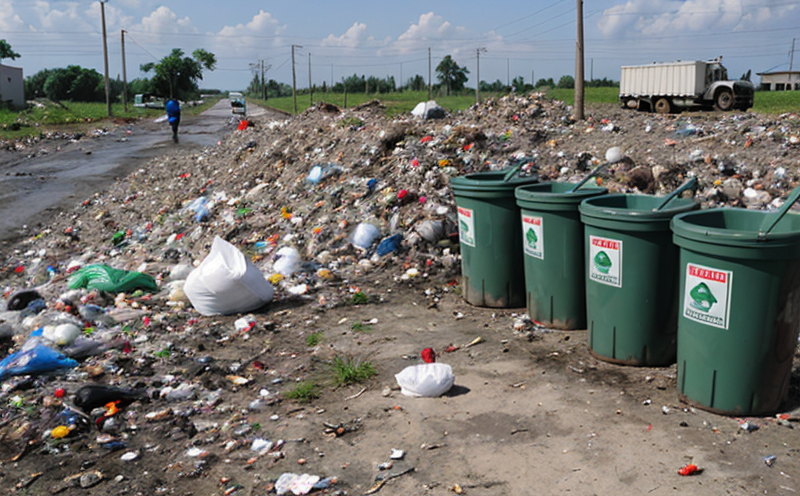ASTM D6009 Sampling of Solid Waste Materials Test
The ASTM D6009 standard provides a comprehensive framework for sampling solid waste materials, ensuring that the collected samples accurately represent the characteristics of the entire waste stream. This is crucial in environmental testing and compliance to regulatory standards such as ISO 11468-3:2017 and EN 15230.
The ASTM D6009 test procedure specifies a methodology for collecting representative samples from solid waste, which can include municipal solid waste (MSW), construction and demolition debris, or other types of industrial waste. The process ensures that the sample taken is both statistically significant and unbiased, thereby providing reliable data for subsequent testing.
The sampling process begins with a thorough assessment of the waste stream to determine its heterogeneity. This involves identifying the various components present in the waste and understanding their distribution within the waste pile or container. Once this information is gathered, a representative sample can be taken using appropriate tools such as grab samplers, augers, or shovels.
Following the collection of the initial bulk sample, it undergoes primary processing to reduce its volume and ensure homogeneity. This step may involve crushing, sieving, or blending the material to create a smaller, more uniform sample that can be analyzed further. The processed sample is then divided into subsamples for different types of testing.
The accuracy of ASTM D6009 sampling is paramount in ensuring compliance with environmental regulations and in making informed decisions regarding waste management practices. For instance, if a landfill operator needs to determine the calorific value of incoming waste streams, accurate sampling ensures that this data can be used effectively for planning and operational optimization.
Additionally, ASTM D6009 sampling supports R&D activities by providing consistent baseline data for new waste treatment technologies. This allows researchers and engineers to compare the performance of different processes under controlled conditions, enhancing the development of more efficient and environmentally friendly solutions.
In terms of compliance, accurate sampling ensures that all stakeholders—whether regulatory bodies or private entities—are working with the same data set. This reduces the likelihood of disputes over the validity of test results and helps maintain a consistent approach across different locations or facilities.
Applied Standards
| Standard | Description |
|---|---|
| ASTM D6009-21 | This standard provides procedures for the sampling and preparation of solid waste materials. It is applicable to a wide range of waste types, including municipal solid waste (MSW), construction and demolition debris, and industrial wastes. |
| ISO 11468-3:2017 | This international standard specifies the procedures for sampling non-homogeneous materials such as solid waste. It ensures that samples are representative of the entire material and can be used for subsequent testing. |
| EN 15230:2014 | This European standard covers the sampling of non-homogeneous materials, including solid waste. It provides guidelines on sample size, collection methods, and handling to ensure that samples are representative. |
The combination of these standards ensures a robust approach to sampling, which is essential for accurate testing and reliable data interpretation. By adhering to these guidelines, laboratories can provide consistent and high-quality results that meet the demands of regulatory bodies and industry stakeholders.
Benefits
The benefits of using ASTM D6009 sampling in solid waste materials are numerous, especially for quality managers, compliance officers, R&D engineers, and procurement specialists. Accurate sampling ensures that all stakeholders have reliable data to make informed decisions.
For landfill operators, the ability to accurately determine the calorific value of incoming waste streams can significantly impact operational efficiency and environmental performance. This information allows for better planning and resource management, leading to cost savings and reduced environmental impact.
In R&D settings, accurate sampling supports the development of new waste treatment technologies by providing consistent baseline data for testing different processes. This enhances the ability to compare and optimize these processes, driving innovation in waste management practices.
For compliance officers, ASTM D6009 sampling ensures that all samples are collected and processed according to international standards, making it easier to demonstrate regulatory compliance. This reduces the risk of penalties or disputes over the validity of test results.
Eurolab Advantages
As a leading laboratory in environmental testing, Eurolab offers several advantages when it comes to ASTM D6009 sampling. Our team of experts ensures that every sample is collected, processed, and analyzed according to the highest standards.
We use state-of-the-art equipment and techniques to ensure accuracy and precision in our sampling processes. Our laboratories are equipped with the latest technology and methodologies, allowing us to provide reliable results that meet the demands of regulatory bodies and industry stakeholders.
Eurolab’s global network of laboratories ensures that we can provide consistent and high-quality testing services regardless of location. This allows clients to have confidence in our results, knowing that they are based on accurate and representative samples.





